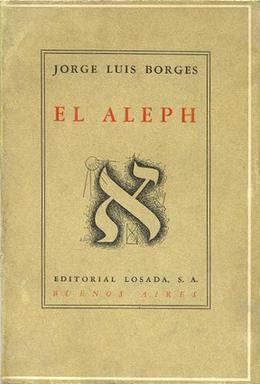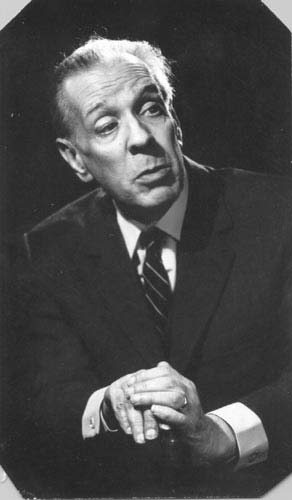Related Research Articles

Jorge Francisco Isidoro Luis Borges Acevedo was an Argentine short-story writer, essayist, poet and translator regarded as a key figure in Spanish-language and international literature. His best-known works, Ficciones (transl. Fictions) and El Aleph, published in the 1940s, are collections of short stories exploring motifs such as dreams, labyrinths, chance, infinity, archives, mirrors, fictional writers and mythology. Borges's works have contributed to philosophical literature and the fantasy genre, and have had a major influence on the magic realist movement in 20th century Latin American literature.

In Greek mythology, the Minotaur is a mythical creature portrayed during classical antiquity with the head and tail of a bull and the body of a man or, as described by Roman poet Ovid, a being "part man and part bull". He dwelt at the center of the Labyrinth, which was an elaborate maze-like construction designed by the architect Daedalus and his son Icarus, upon command of King Minos of Crete. The Minotaur was eventually killed by the Athenian hero Theseus.

Adolfo Bioy Casares was an Argentine fiction writer, journalist, diarist, and translator. He was a friend and frequent collaborator with his fellow countryman Jorge Luis Borges. He is the author of the Fantastique novel The Invention of Morel.
"The Zahir" is a short story by the Argentine writer and poet Jorge Luis Borges. It is one of the stories in the book The Aleph and Other Stories, first published in 1949, and revised by the author in 1974.
"The Immortal" is a short story by Argentine writer Jorge Luis Borges, first published in February 1947, and later in the collection El Aleph in 1949. The story tells about a character who mistakenly achieves immortality and then, weary of a long life, struggles to lose it and writes an account of his experiences. The story consists of a quote, an introduction, five chapters, and a postscript. "The Immortal" has been described as "the culmination of Borges' art" by critic Ronald J. Christ.

Labyrinths is a collection of short stories and essays by Argentine writer and poet Jorge Luis Borges. It was translated into English, published soon after Borges won the International Publishers' Prize with Samuel Beckett.

The Aleph and Other Stories is a book of short stories by Argentine writer Jorge Luis Borges. The title work, "The Aleph", describes a point in space that contains all other spaces at once. The work also presents the idea of infinite time. Borges writes in the original afterword, dated May 3, 1949, that most of the stories belong to the genre of fantasy, mentioning themes such as identity and immortality. Borges added four new stories to the collection in the 1952 edition, for which he provided a brief postscript to the afterword. The story "La intrusa" was first printed in the third edition of El Aleph (1966) and was later included in the collection El informe de Brodie (1970).

Emir Rodríguez Monegal, born in Uruguay, was a scholar, literary critic, and editor of Latin American literature. From 1969 to 1985, Rodríguez Monegal was professor of Latin American contemporary literature at Yale University. He is usually called by his second surname Emir R. Monegal or Monegal.

This is a bibliography of works by Argentine short-story writer, essayist, poet, and translator Jorge Luis Borges (1899–1986).
"The Aleph" is a short story by the Argentine writer and poet Jorge Luis Borges. First published in September 1945, it was reprinted in the short story collection, The Aleph and Other Stories, in 1949, and revised by the author in 1974.

"The Garden of Forking Paths" is a 1941 short story by Argentine writer and poet Jorge Luis Borges. It is the title story in the collection El jardín de senderos que se bifurcan (1941), which was republished in its entirety in Ficciones (Fictions) in 1944. It was the first of Borges's works to be translated into English by Anthony Boucher when it appeared in Ellery Queen's Mystery Magazine in August 1948.
"The House of Asterion" is a short story by Argentine writer Jorge Luis Borges. The story was first published in 1947 in the literary magazine Los Anales de Buenos Aires and republished in Borges's short story collection The Aleph in 1949. It is based on the Greek myth of Theseus and the Minotaur and is told from the perspective of Asterion, the Minotaur.
"The Wait" is a 1950 short story by Argentine writer Jorge Luis Borges. It was published in the collection The Aleph. David Foster Wallace referred to the story as "marvelous".
"Borges and I" is a short story by the Argentine writer and poet Jorge Luis Borges. It is one of the stories in the short story collection The Maker, first published in 1960.

Finca Los Alamos is a historic Argentine estancia located in San Rafael, Mendoza. The estate was built in 1830 by the Bombal family, and originally served as a frontier fort. Domingo Bombal, who served eleven terms as Governor to the Mendoza Province, owned the estate until his death in 1908.

The Qedarites were an ancient tribal confederation of Arabia centred in their capital Dumat al-jandal in the Al-Jawf Province. Attested from the 9th century BC, the Qedarites formed a powerful polity which expanded its territory throughout the 9th to 7th centuries BC to cover a large area in northern Arabia stretching from Transjordan in the west to the western borders of Babylonia in the east, before later consolidating into a kingdom that stretched from the eastern limits of the Nile Delta in the west till Transjordan in the east and covered much of southern Judea, the Negev and the Sinai Peninsula.
"The Theologians" is a short story by Argentine writer Jorge Luis Borges. It was featured in the collection Labyrinths. It was originally published in Los Annales de Buenos Aires in April 1947 and appears in the 1949 short story collection The Aleph.

Estela Canto was an Argentine writer, journalist and translator best known for her relationship with Jorge Luis Borges.

Jorge Luis Borges and mathematics concerns several modern mathematical concepts found in certain essays and short stories of Argentinian author Jorge Luis Borges (1899–1986), including concepts such as set theory, recursion, chaos theory, and infinite sequences, although Borges' strongest links to mathematics are through Georg Cantor's theory of infinite sets, outlined in "The Doctrine of Cycles". Some of Borges' most popular works such as "The Library of Babel", "The Garden of Forking Paths", "The Aleph", an allusion to Cantor's use of the Hebrew letter aleph to denote cardinality of transfinite sets, and "The Approach to Al-Mu'tasim" illustrate his use of mathematics.
"Story of the Warrior and the Captive" is a short story by Argentine writer Jorge Luis Borges. It first appeared in 1949 in the short story collection El Aleph and later appeared in Labyrinths.
References
- ↑ Borges, Jorge Luis (2016). Textos recobrados 1931-1955 (in Spanish). Buenos Aires: Sudamericana. p. 200. ISBN 978-950-07-5568-9.
- ↑ (in Portuguese) "Os dois reis e os dois labirintos" (2006), by Alexandre Luís de Mello. In: Itu.com.br. Consulted on January 3, 2010.
- ↑ Boldy, Steven (2013). A Companion to Jorge Luis Borges. Boydell & Brewer Ltd. p. 58. ISBN 978-1-85566-266-7 . Retrieved 4 July 2024.
- ↑ Noys, Benjamin (28 December 2023). Crisis and Criticism: Literary, Cultural and Political Essays, 2009–2021. BRILL. p. 132. ISBN 978-90-04-68958-9 . Retrieved 4 July 2024.